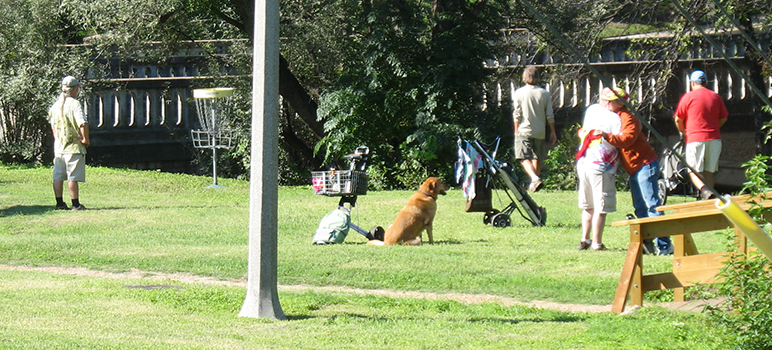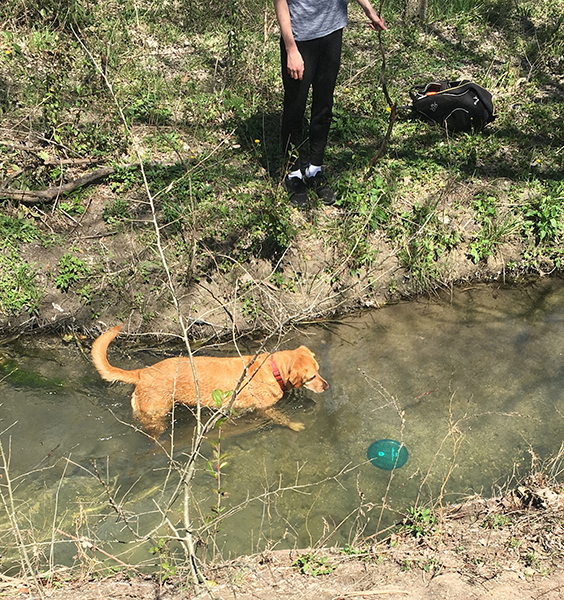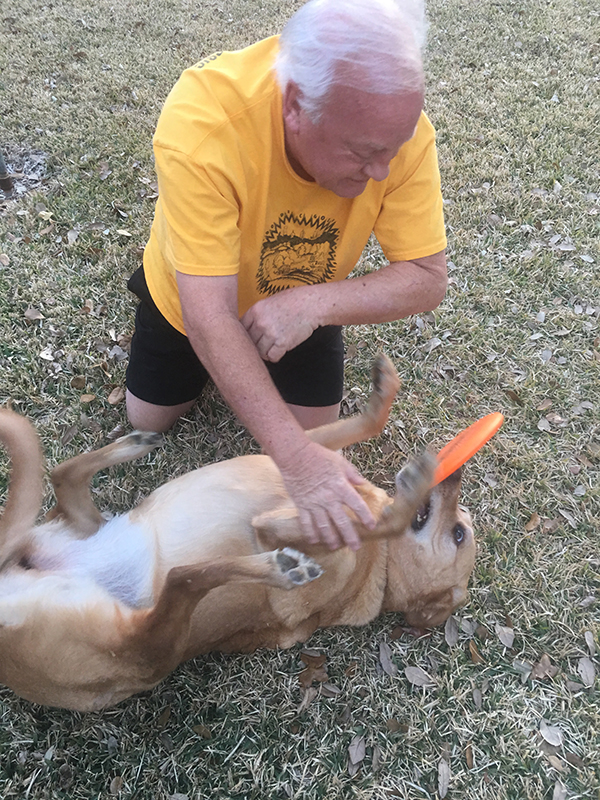Practical Dog-training Tips

Charlie, dog of Jennie Weigand 158303 and Matt Nance 38816
Have you read the article in the Summer 2022 issue of DiscGolfer Magazine about training your dog to be a pro-level disc golf retriever? In it, you’ll learn how Autumn and owner John Brady became a dynamic duo on the course. If you’re interested in training your puppy, here are Brady’s recommendations:
Choosing your puppy
- You’ll want to start with a puppy since early-life training is critical. A breed with a mellow temperament is important since more submissive dogs are easier to train.
- Use Volhard’s Puppy Aptitude Testing method to find your best match. The Volhard test pinpoints a puppy’s tendency to develop a dominant or submissive personality. It also gives you clues whether a puppy has a prevalence to be a consistent retriever.
- Although there are some recent studies that claim breeding has little bearing on a dogs behavior, golden retrievers and labs were bred over hundreds of years to be bird retrievers. Regardless of how they got there, these type of dogs are a natural choice because they have “soft jaws” meaning they can be trained more easily to be gentle with their cargo and not bite into select objects – like golf discs. They often carry the disc balanced on a lower tooth, kind of like a putt hanging on a basket nub. Golden retrievers visually track flying objects better than many other breeds too. Pragmatically, a golden retriever/lab mix is ideal simply because the shorter hair makes life easier for the owner of a dog who’s job it is to get into water and bushes.
Teaching your dog to stay and sit patiently during a round of disc golf is essential.
Basic early training
- Read up on basic dog training using one of the many books that are available. Dog training has not changed much over the decades so an older book works just as well as a new one. Combining the fundamentals of well-trained dogs with the details of disc retrieving is critical.
- Begin your training soon after the puppy is weaned from its mother. Usually this is around eight or nine weeks old. The first six months of training is the most important. Plan on two sessions per day of about 15 minutes each day. The phrase “the process is the result” truly applies here. If you are willing to spend this time on your retriever early in their life, you will reap the rewards for many years to follow. Above all, be patient with your pup.
- Be the dog. Think ahead what they might do when you’re not there – like chew on your favorite disc. Teach your puppy to love discs and be gentle with them with constant exposure while in your presence. Just like you would never leave your shoes in a room alone with a puppy, never leave discs in a room without you supervising. Purposefully watch your puppy with discs present and if they try to chew on a disc simply replace it with an allowable chew toy. Keep repeating this process and your pet will come to understand the difference within a few sessions.
- Anything associated with eating is good. Feed and water your pup using discs for bowls. Award your dog with treats as they are learning, but ONLY using food motivation during training sessions. Avoid special “treat products” since they are not as healthy as a simple piece of dog food – and your dog will equally appreciate the normal dog food. Feed your puppy twice a day at consistent times and occasionally delay mealtime until after a training session so they are extra responsive to a treat based training session.
- Use consistent voice commands and remember dogs are very responsive to audible tones. A louder command when they stray from their training mimics a mother dog’s warning in their mind. The exact words are not critical as long as you use the same specific phrase for each specific command. Remember to praise them with a softer tone whenever they perform a command correctly. Be consistent with that phrase as well – typically “good girl/boy” or something similar.
- Hand signals are very important during every phase of training. Each different command should have its own distinctive hand signal and they should be used consistently. Hand signals become even more important on the course where verbal commands can be disruptive to other players.
- The most important command to teach your dog is “leave it.” A good method to teach this command is to block their food with your hand and say “leave it” with a loud and firm tone. This command will be used more than any other on the disc golf course. You can reinforce it by only letting them eat once you give them a go-command such as “okay, eat.” Do this drill several times in a short burst to reinforce it in the dogs memory. And only use “leave it” for food and discs.
Water retrieval is a great skill for your disc golfing dog to learn.
Disc doggie specific training
- While your pet is still a puppy, use a lightweight disc as a fetch toy. Use voice control to stop them from chewing and praise them when they do it right. Use consistent distances all week, like 5, 10, 20 feet and repeat. Daily fetching should last several weeks and be sure to increase the distance over time. And remember, there’s nothing your puppy appreciates more than to make you happy so during each fetching session award them occasionally with a kind word and little treat.
- Always use the same word each time when you want them to retrieve like “fetch” or “Frisbee.” Also, train them NOT to fetch by using a different word like “pause” or “stop.” In general, be consistent with your commands.
- You must do some training every day, twice a day to increase the memory of the previous training. “Sit” and “stay” are also important commands since they are used to keep your dog quiet and still on the course.
- While your retriever is a puppy water training is essential. To start, use a baby pool with about one inch of water. Place your puppy in the water with a disc and let them play, and later on while doing fetching practice toss the disc into the water. As long as they know a treat is coming they will have no issue with getting into the water.
- For visual training, toss discs in the air at close range for emphasis and focus on fetching and not mid-air catching. A cloth disc works well for this eye-training so you can also work on this indoors when outdoor time is not possible.
- Whatever training you work on each day make sure the dog is given attainable goals. You can increase distance and difficulty over time. As they become more confident you eventually will see the development of a mature and fully trained retriever.
Make sure your training sessions are fun for both of you.
On-course training
- When you feel like your young retriever is ready, get on the course and train with a leash. At first they might want to fetch every flying disc they see so use the leash to enforce the “leave it” command. Eventually they will distinguish between “fetch” and “leave it” without the need of a leash.
- Another important on-course command is “back.” Your dog needs to know when you want them to sit behind you which allows you to control their exact position and motion relative to other players. This command is most handy when someone in your group is putting. Your dog should always sit when near circle one.
- Early on make sure your trainee has fun on the course by staying busy. Play often while your retriever while they are young and antsy. A few times each round purposely throw a disc into shallow water or in some trees. This gives them — and you — a chance to practice as a team. Bring treats and offer lots of praise.
- If you’re playing with others, make sure they are supportive of having your pup walking along. If they need a disc retrieved always ask them first if it’s OK to send your dog. Make sure you say “we’ll try” since not every disc is retrievable and you want to correctly set expectations. The first time the disc owner will ask about biting on the plastic, and at this point the training should be far enough along you can assure the there will be no teeth marks. It’s showtime!
- Many disc golfers consistently play with the same small group of friends. If your dog will usually be around the same group of players, it’s best they all know the correct commands and hand signals. This is more for consistency in the mind of the dog although you should always be ultimately responsible for your own pet.
- Always make sure you’re your sending your retriever into a safe situation. Only the owner should decide when to send the dog into action. Know your dog’s strength and swimming ability. Avoid water retrievals in soft, muddy bottom areas. And remember, your dog will self regulate instinctively. For example, in training, John once sent Libby after a roller in motion and when the disc took a turn and crossed a cattle guard, Libby automatically stopped and slowly negotiated that crossing.
- Help locate discs in water by pointing at them. If they can see it, they can get it. If the disc is not visible, drop a small rock into the water over where the disc is likely located. Use your “fetch” command and once they get into the water they will understand you actually wanted the disc. Your retriever is bred to submerge to a certain extent. Autumn is able to maintain an underwater retrieval for 10 to 15 seconds at a time.
- Play as much as possible as a team for the first year, however, no matter how trained your retriever is, never expect to have them accompany you in a PDGA-sanctioned tournament round. You should not even ask for permission from the other players on your card or the tournament director since competing with pets is explicitly against the rules. Of course, occasionally there are special disc golf events where dogs are invited to walk along.
- Always remember there is nothing your dog likes more than to please you, so make a few minutes of retrieving a daily and lifetime activity.
We hope this article helps you and your best friend enjoy your rounds of disc golf more than ever before.
- posted 4 days ago
- posted 1 week ago
- posted 1 week ago
- posted 1 week ago
- posted 2 weeks ago
- 1 of 703
- next ›



